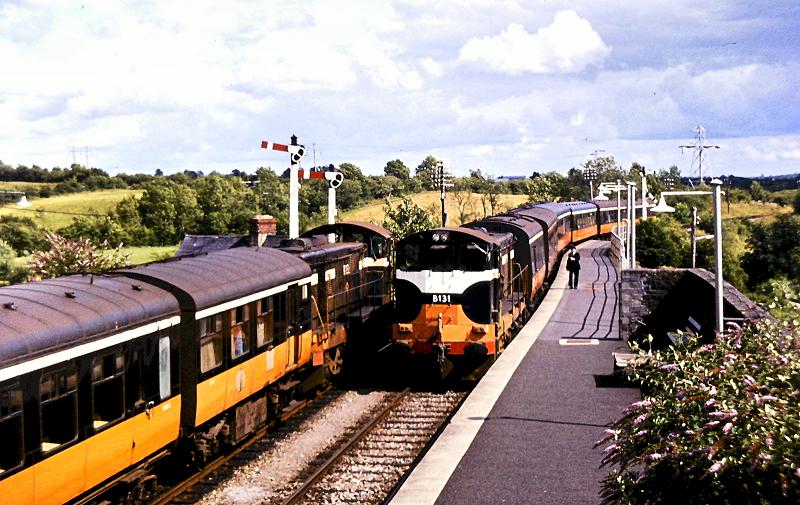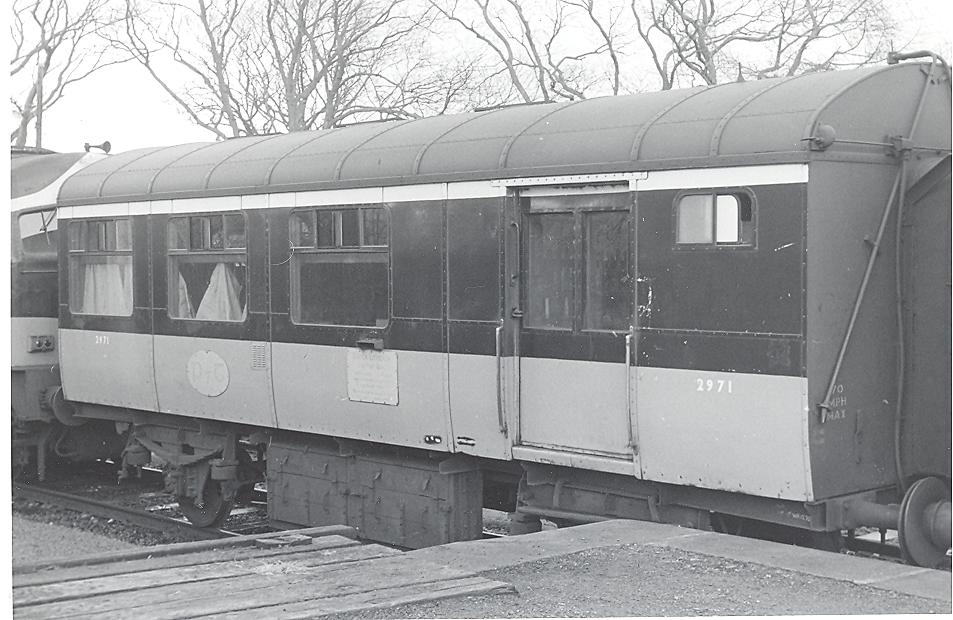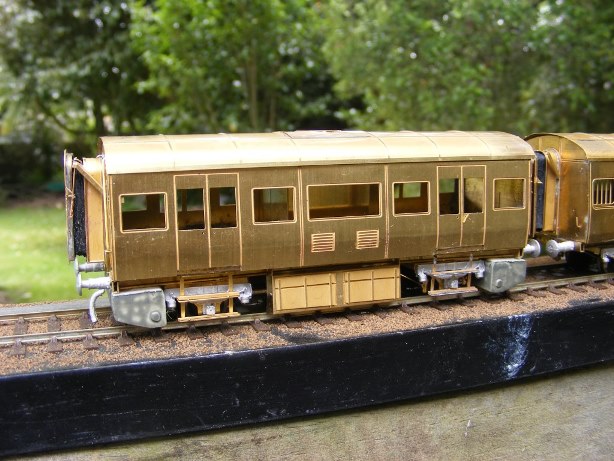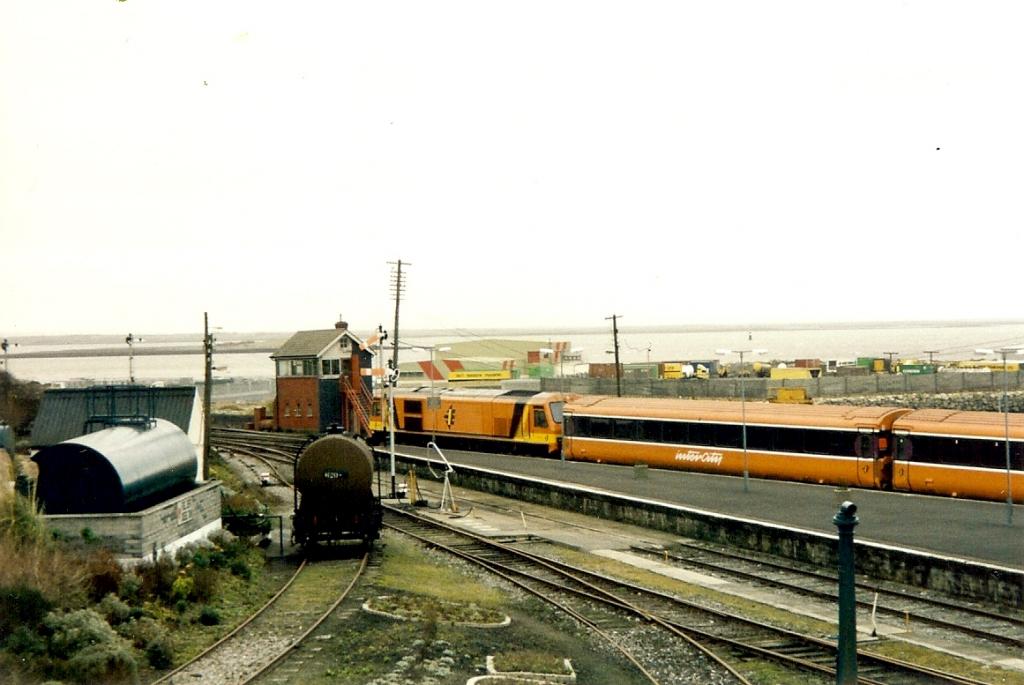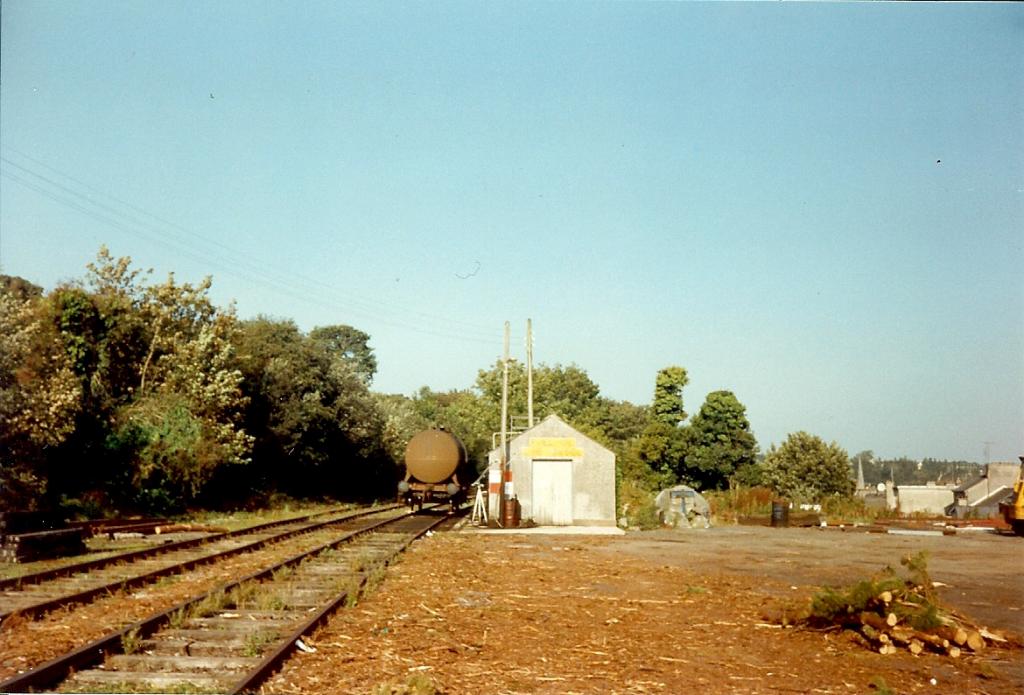-
Posts
4,734 -
Joined
-
Last visited
-
Days Won
118
Content Type
Profiles
Forums
Resource Library
Events
Gallery
Blogs
Store
Community Map
Everything posted by Mayner
-
You big tease
-
Asking price dropped by $200k now on Al Jazeera http://www.youtube.com/watch?v=CKj_5cbMrksThe owners let the cat out of the bag in a 2010 interview. Council had refused resource consent to develop the township due to risk of flooding & earthquake.
-
I will probably look at doing the Achill Bogie at some stage after the G2 2-4-0 and Midland Standard goods. 2050?.
-
There were 10 4w Sorting Vans, they seem to have been used to replace pre-amalgamation 6 w TOPs on secondary lines main lines. Up and Down afternoon Sligo trains crossing at Carrick on Shannon 1975 © J W Sutherland. Interesting comparison in body profiles between early MK2 Bredin and later Laminate/Craven period stock The TPO has a similar profile to the 1st coach an early (1953) CIE Second Open. The heating van at the head of the down train is a 6 wheeler with a similar profile to the Laminates and Cravens, the rest of the train appears to be a mix of early CIE stock and Park Royals. The van in David Malone's photo appears to be coupled to a 4w luggage van possibly as part of the Night Mail to Mullingar.
-
Otira is a bit like Keddie on the Western Pacific a railway ghost town that never quite made it as a holiday resort. The town and hotel came on the market when the electrified operation through the tunnel ceased in the late 1990s. [video=youtube;h7_B-Xs2f1I] The main draw back is that Arthurs Pass at the top of the pass is much better sited and gets most of the trade, the Hotel only fills up when the road through the pass is blocked with ice and snow.
-
If you are going to that degree of accuracy, it would probably be a good idea to visit Whitehead and measure up 171s motion the class was "renewed" in the 1930s and the motion may not be the original. An IRRS London Area member Richard McLachlan richardvmcl@aol.com is working on indexing and digitising a large proportion of GNR loco drawings which turned up in a clear out at Inchacore Works in 2011 after being "lost" when Dundalk Works closed after the break up of the GNR. The drawings appear to include component drawings with enough information to build a new full sized locomotive!
-
The chance of a lifetime, Hotel with view and village for sale http://www.trademe.co.nz/a.aspx?id=546832018 I stayed in the Hotel once it was an interesting experience
-
Think of the modellers dilemma of deciding whether to work OO, HO or TT if the Irish North stayed open and GNR had gotten its way and bought a fleet of German diesel hydraulics . The GNR engineers and traffic people appear to have wanted something similar to the DB V90 for heavy passenger and freight use http://en.wikipedia.org/wiki/DB_Class_V_90 with most of the German builders tendering with MAK & Jung coming closest with 1000Hp B-B units similar to the V90s.
-
The 1st batch of vans is largely sold out and should be winging their way to the Northern Hemisphere after Christmas. A small number of vans are currently available at $105NZ +$20 shipping. If there is sufficient interest I will look at producing the TPO/Heuston Tool Van version. Sligo TPO Photos © David Malone I want to thank the lads for their patience over the past few years waiting for the kits to arrive and support in jumping into somewhat unknown water with brass kits. I will put up a tutorial when I get a chance to help with the assembly.
-
Assembly considered an Enniskillen rail link as part of its long term transport planning, but the costs substantially outweighed the benefits. Any to the realms of dreaming A layout based on Irish North operating patterns would be fascinating, an interesting mix of steam, diesel railcars and horse power . Passenger trains generally short with more vans and wagons than coaches. Enniskillen was basically a double ended terminus with only the Bundoran Express and one or two Dundalk-Derry passenger trains working through and quite complicated workings between Enniskillen and Bundoran Junction. Add in the SLNCR yard the mix becomes even more bizarre. Passenger trains dropped off bread container vans at most stations. Freight workings could be heavy with through cattle trains to Belfast, Greenore and Derry off the SLNCR, going the other way Sligo received bagged cement from Drogheda over the GNR from Omagh. Building stock would be challenging many of the locos are available in kits, Leslie does suitable wagons.
-

Just a memory - Phibsboro Modellers Shop
Mayner replied to Sulzer201's question in Questions & Answers
Monck Place seemed to be on the go from the early 70s, on Saturdays and school holidays used to get the 23 bus into town check out Southern Model Railways in the Grafton Arcade, Terry's Toy Shop in Henry Street and then walk across to Monck Place. There were a lot of changes in those days, got my first proper train set in Terrys Toy Shop the "South African Goods" a Triang Hornby M7, 4 wagons and an oval of track all in BR colours! Southern Models Railways was still on the go in Lr Leeson Street beautiful Trix Intercity DMUs bought a Trix E2 and a Triang Hornby CKD coach kit before they moved to Grafton Arcade. Traded in the M7 for a Hornby diesel shunter in Monck Place. Terry's had shops in Henry and Georges Street large stock of Triang Hornby and Hornby O gauge wagons. Bicycle and electrical appliance stores stocked Traing Hornby Mc Hugh Himself under the Loop Line Bridge Talbot Street, a similar shop opposite M&S in Mary Street. A bicycle shop under Arnotts in Liffey Street stocked a lot of raiulway stuff including lots and lots of Merit figures and accessories, most tantalisingly a shop on the corner of the Green and Grafton Street had a huge stock of Triang Series 3 track and Block Instruments. Southern Model Railways used to stock a lot of British Trix and commissions by Harry Connaughton including an O gauge GNR Compound, The assistant Eddie Elliott was extremely tolerant and helpful, the business was later sold to Mark and moved to Dolier Street. Out in the burbs John Byrne was involved in a model shop in Rathfarnham Shopping which became a showcase for Irish Lima, Dennis Lonergan the MRSI secretary helped out on Saturdays and sometimes brought along his kit built locos. John Byrne later set up a hobby shop in the office block at the back of Clerys. George Hannon Malahide art and model shop was a Saturday afternoon retreat for modellers, sometimes George would show off some of his scratchbuilt locos often got the train out from Connolly and a lift back into town. In those days I was mainly a window shopper with regular subscription to the Modeller and Model Railways. I am not sure what the shopkeepers though, but they always seemed to be friendly and tolerant of my comings and goings and rarely buying anything. Ah the pipe smoke in Monck Place I can still taste it! -
Amazing mid-November just a hint of Autumn foliage, really smartly turned out railway interesting mix of 19th Century buildings, modern rolling stock and infrastructure, far cry from the dilapidated railways of the 70s and 80s.
-

Just a memory - Phibsboro Modellers Shop
Mayner replied to Sulzer201's question in Questions & Answers
I used to visit the shop quite frequently in the 70s when I seldom had money to buy anything , the counter was like a jewellers display case full of scratch builders parts. The main money spinner seemed to be around importing Liliput, Piko and Trix direct from the continent, they had a loyal customer base among the continental modellers and ran a kind of savings club where you could place and order and save up for what were then quite expensive models. -
There seems to be a surprising gap for suitable trucks between the 60s-90s. One of the Corgi or EFE flatbed Atkinson, AEC or Leyland artics might pass muster for a hacker picking up 20' containers from the railway. No one seems to do a Guy Big J tractor unit, these were used by CIE up to the Scan. truck era, but it might be possible to graft the cab off a rigid onto an artic chassis. Livery was simple black cab broken wheel emblem on the doors.
-
Heard a whisper through the grapevine, book on the Limerick & North Kerry by A J O'Rourke to be launched at the Lartigue Museum, Listowel 7pm, Sunday 24th November. No idea of its contents but Alan is the HMRS Irish Stewart, editor of New Irish Lines and models the GSWR in 4mm scale.
-
Unlikely to be for the shillings unless the Bluebell is getting rid of the kettles and putting in a bid to re-open the line to Lewes and start competing for London Brighton commuter traffic:ROFL: Dick Fearn's reputation in the UK was largely based on his modernisation of Chiltern and Thames Valley Commuter services with Turbo-Star units replacing loco hauled trains and 1st generation DMUs on the lines out of Paddington and Marylebone. Those 1st generation high density DMUs were hard riding for 60 plus mile run from Banbury to Marylebone This laid the groundwork for competing London-Birmingham commuter services with Chiltern Trains using mainly ex GWR/Western Region Birmingham line and Virgin West Coast the ex LMS route. A number of senior ex-BR managers have ended up with Chairmanships of Heritage lines Dr John Prideaux the last Intercity Chairman ended up with the Festiniog after an involvement with Heathrow Express and the Channel Tunnel link.
-
Two of my favourites. I was once misguided enough one Friday night to watch the re-fuelling of a pair of 201s rather than check out the bars around Eyer Square. The bunded tank and tripod arrangement seems to date from the 90s, Westport still had a single skinned tank on a concrete base similar to the Ratio Fuel Tank kit http://www.anticsonline.co.uk/1343_1_1039763.html
-
Taking Irish scenic modelling to a whole new height and showing what can be achieved in a small space. I am a great fan of the Will's Scenic sheets, the effect seems to be even better in 7mm Iain Rices book on making the most of the kits has been my bible for over 20 years and I am still learning http://www.amazon.co.uk/product-reviews/0906867711/ref=olp_pr_see_all_top?ie=UTF8&showViewpoints=1
-
Not quite the same scale one of our local garden railway members has a passenger carrying line in the garden in additional to G Scale. https://www.facebook.com/SquirrelValleyRailway. Most operators tend to go for narrow gauge or freelance locos, basically a scale model of 800 or a Compound would look very nice but be hardly able to pull the skin off a rice pudding. Better a freelance 0-4-0 with a large boiler than a scale model of a pacific or big 4-6-0.
-
https://maps.google.com/?ll=45.38879,-122.93210&z=19&t=h watch out for Big Foot and the Grizzly Bar
-
Some playing around with the video function and editor. Imagine its 1958 a group of railfans have decided to explore and chase trains on the relatively undocumented western extension of the Arigna Tramway. Starting out at Boyle the group chase a mixed train to a crossing point with a coal special filming the arrival of the mixed and departure of the coal train with some panned shots on a roadside tramway section. 6T on the roadside section with the 12:30 Boyle-Ballinamore mixed. 6T arriving at Keadue, 3T waiting with a coalie. 3T departing. 3T on roadside section All I need to figure out is how to improve the photo editing and add realistic sound and smoke effects
-
I agree Courtmacsharry definitely deserves the Dave Holman treatment with a little help from Glenderg! Apart from lifting the track little seems to have changed in the 50 odd years since closure http://eiretrains.com/Photo_Gallery/Railway%20Stations%20C/Courtmacsherry/IrishRailwayStations.html I looked seriously at modelling the T&C in 7mm as nearly all the locos and shortie bogie coaches are available from Alphagraphix, but decided to stick with 4mm. The T&C was probably the nearest thing in Ireland to classic Light Railways like the Colonel Stephens lines, with its odd locomotive collection and wooden and corrugated iron buildings. While a simple light railway it could get surprisingly busy with double headed seaside excursions from Cork and heavy beet and cattle traffic from Timoleague.
-
I got the horsehair along with some scatter material from International Models/Anita Décor at Warley about 10 years ago, and finally got around to using it unaware that its difficult to find. I decided on a mixture of low hedging and post and wire fence in the foreground, so you can still see the road and the trains. I used Woodland Scenics "fine leaf foliage" a natural product glued on top of the horsehair to represent the hedging & applied some extra ground cover to disguise the gap between the fascia and the edge of the scenery. The gate posts are stripwood painted with Humbrol acrylic paint, the post and wire fencing uses Slaters plastic posts and stripped down hook up wire. https://slatersplastikard.com/assets/pdfs/FencingFlyer.pdf. I will probably use the Slaters posts with plastic rodding rather than wire for fencing the line through the cutting around to the loco shed. Not quite stockproof fence with typical Irish field gate. A couple of railway enthusiast cars parked awaiting a photo of the afternoon mixed? The Children of Lir? and a couple of ducks. Swimming in "realistic water" nothing much for a swan or duck to eat or drink. I use 3x1" pine for the baseboard framing with the track and road on 12mm mdf, the framing is notched out locally in two places for the river/lake bed in 6mm mdf. The fascia covers up most of the skulduggery. Ford Prefect waits at the town gates. I finally got around to completing the roadway at the level crossing. I had put off this job for quite a while, the Bemo flexible track used is quite delicate and managed to pull one of the rails out of its fixings and I did not fancy replacing the panel back to the next joint on the station side of the crossing. In the end the track was quickly repaired by soldering in a copper clad sleeper and I completed the roadway across the crossing with strip-wood sleepers stained to look like creosote. The roadway was then coated with pva and a dark Woodlands Scenics fine scatter coat sprinkled on, a cold version of tar and chips, this seems to have matched up nicely with the entrance to the goods yard and loading bank. The p.w. gang is preparing to do some spot re-sleepering and swap out worn rail with sleepers and rail stored by the crossing, the County Council has still to provide footpaths and tar the road past the houses to the station. I badly need some 1950s era signs for the buildings around the station area and tramway. The crossing gates are from the Wills scenic series and fairly typical of CIE gates up to the boom era. The C&L level crossings were pretty inconsistent with targets and lamps, some had targets some had lamps. This end of the layout still needs a little thought about hiding/disguising the hole in the backscene, Presently there is no room for expansion as this end of the layout projects into a window and across our cats' day bed.
-
Most of the smaller items would have been loaded/unloaded by hand most trucks doing local deliveries had a helper to assist with the loading unloading. Most goods yards and some goods sheds had hand operated cranes for unloading large items like farm machinery and containers. Coles cranes similar to the Corgi model were a popular 60s era railway and steelyard crane, one was parked up for many years in Mullingar goods yard. https://www.corgi.co.uk/shop/trackside/dg226000-coles-argus-6-ton-crane-yellow/
-
Sounds suspiciously like Ockie our black-short hair domestic who dares the train to run her down.
.png.c363cdf5c3fb7955cd92a55eb6dbbae0.png)

